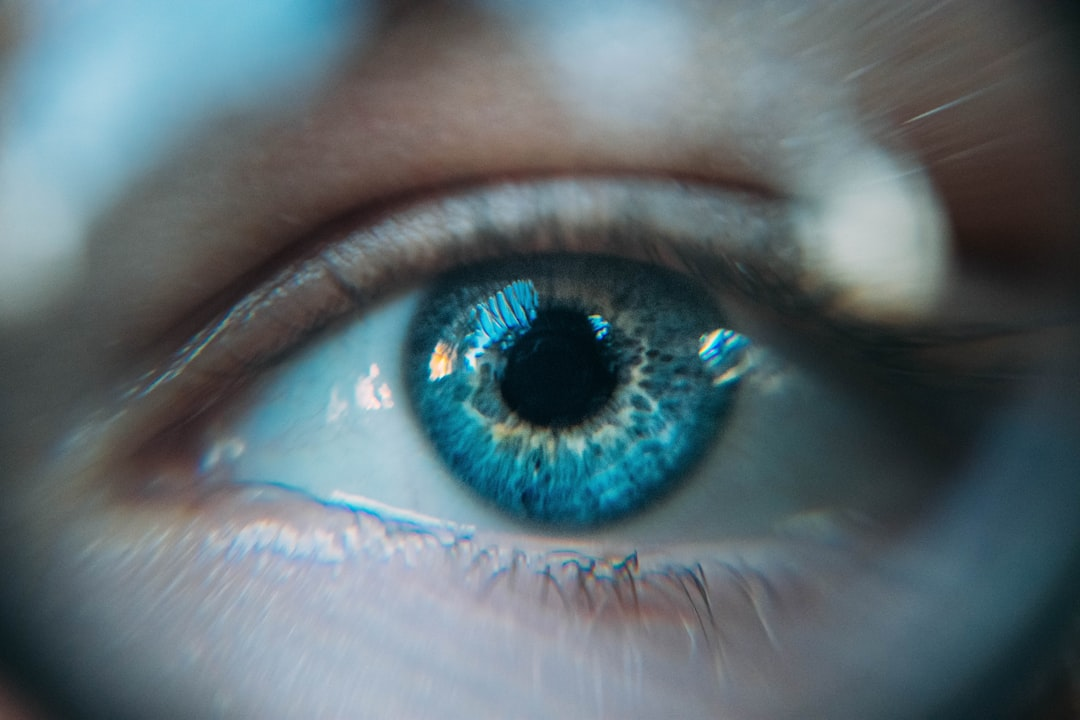
What if the very light that illuminates our world could also be a powerful healer for our eyes? For too long, the idea of using light as a therapeutic tool for ocular health has been overshadowed by conventional treatments. Yet, a burgeoning field of science is revealing that specific wavelengths, particularly red and near-infrared light, hold profound potential to revolutionize how we approach eye care.
For a complete overview of this topic, refer to our main guide on Biohacking Vision: The Ultimate Guide to Eye Health & Clarity.
This definitive guide delves into the intricate science behind light therapy for eye health, demystifying its mechanisms and exploring its applications for a range of conditions. Prepare to gain a transformative understanding of how targeted light can support cellular repair, reduce inflammation, and enhance mitochondrial function, empowering you with knowledge to navigate this innovative frontier and potentially unlock new pathways to preserve and restore your vision.
💡 Key Takeaways
- Specific wavelengths, especially red and near-infrared light, profoundly influence eye health at a cellular level by enhancing mitochondrial function and reducing oxidative stress.
- Light therapy shows promise as a non-invasive adjunctive treatment for various ocular conditions, including age-related macular degeneration, dry eye syndrome, and glaucoma.
- Understanding proper protocols, device safety, and consulting healthcare professionals are crucial for maximizing benefits and ensuring safe application of light therapy.
- This innovative field represents a significant paradigm shift in eye care, offering new hope and potential for vision preservation and recovery beyond traditional approaches.
In This Article
💡 Fundamentals & Science

Alright, let’s pull back the curtain on how light, a seemingly simple element, becomes a potent therapeutic agent for your eyes. This isn’t just about ‘brightening’ your vision; it’s about optimizing the fundamental biology of your ocular system.
🔬 The Cellular Symphony of Light
At its core, light therapy for eye health is about harnessing specific wavelengths of light to stimulate cellular processes. Think of your cells as tiny power plants, and these specific light frequencies act as the ultimate efficiency engineers, signaling them to work optimally. We’re primarily focused on two key players here:
- ✅ Red Light (typically 600-700 nanometers): This is your cellular energizer. It’s often associated with surface-level benefits but penetrates surprisingly well into the retina, stimulating mitochondria and boosting energy production.
- ✅ Near-Infrared (NIR) Light (typically 700-1000 nanometers): This is where the magic truly deepens. NIR light penetrates further into tissues, reaching the critical structures at the back of your eye. It’s emerging as a powerful tool for ocular repair and regeneration, a topic extensively reviewed in a publication on Near Infrared (NIR) Light Therapy of Eye Diseases in PMC.
⚙️ How Light Sparks Healing: The Mitochondria Connection
So, how exactly does shining a specific light on your eyes translate into improved vision and eye health? It largely comes down to your cells’ energy centers: the mitochondria. These are the powerhouses responsible for producing Adenosine Triphosphate (ATP), the energy currency of your cells.
Here’s the breakdown:
- ✅ The Cytochrome c Oxidase (CCO) Key: When red and NIR light hit your cells, they are absorbed by a specific enzyme within the mitochondria called cytochrome c oxidase (CCO). Imagine CCO as a tiny, highly sensitive antenna. When it absorbs these particular light wavelengths, it undergoes a conformational change.
- ✅ Unlocking ATP Production: This change in CCO then leads to a cascade of beneficial effects. It essentially helps to ‘unclog’ or optimize the electron transport chain within the mitochondria, allowing for more efficient and robust ATP production. More ATP means your eye cells have more energy to perform their vital functions – repairing damage, reducing inflammation, and even regenerating new cells.
- ✅ The NO Factor (Nitric Oxide): Furthermore, light therapy can help release nitric oxide (NO) from CCO. NO is a vital signaling molecule that improves blood flow (vasodilation) and reduces oxidative stress, creating a healthier environment for your eye tissues. It’s like clearing out the traffic on a busy highway to allow vital resources to flow freely.
Why Your Eyes Are Prime Candidates for Light Therapy
Your eyes are particularly receptive to this form of therapy for several reasons:
- ✅ High Metabolic Demand: The retina, in particular, is one of the most metabolically active tissues in your entire body. It demands a huge amount of energy to constantly process visual information. This high energy demand makes it especially vulnerable to mitochondrial dysfunction but also highly responsive to therapies that boost mitochondrial output.
- ✅ Accessibility: Unlike many internal organs, your eyes are relatively accessible to external light sources, allowing for direct, non-invasive treatment.
- ✅ Transparent Media: The clear structures of the eye (cornea, lens, vitreous humor) allow light to pass through efficiently, reaching the deeper retinal layers where much of the benefit occurs.
In essence, we’re giving your eye cells a metabolic supercharge, empowering them to heal, regenerate, and function at their peak. It’s a fundamentally biological approach to eye health.
🌈 Light Spectrum & Benefits

You might think of light primarily as what you see, but the electromagnetic spectrum is a vast orchestra of energies, only a tiny fraction of which is visible to the human eye. Just as different foods provide unique nutrients to your body, specific wavelengths of light deliver distinct biological signals to your cells, particularly those in your eyes. And some of these signals are incredibly beneficial, almost like a precision-tuned superfood for your vision.
🔴 The Power of Red Light (600-700nm)
When we talk about therapeutic light for eye health, the red light spectrum is often your first stop. Specifically, wavelengths in the 630nm to 670nm range are incredibly potent. But why?
Imagine your eye cells, especially the metabolic powerhouses like photoreceptors and retinal pigment epithelial (RPE) cells, as tiny, bustling factories. They need constant energy to function, repair, and regenerate. Red light acts like a direct, highly efficient fuel injection for their engines – the mitochondria. When light in this specific range hits your cells, it’s absorbed by a key enzyme within the mitochondria called cytochrome c oxidase (CCO). This absorption triggers a cascade of events:
- ✅ Increased ATP Production: This leads to a surge in ATP (adenosine triphosphate), the primary energy currency of your cells. More ATP means your eye cells have the energy they need to perform their functions optimally, whether it’s processing light signals or clearing metabolic waste.
- ✅ Reduced Oxidative Stress: It helps neutralize damaging free radicals, protecting delicate eye tissues from oxidative damage, a major contributor to many age-related eye conditions.
- ✅ Enhanced Blood Flow: Red light can promote vasodilation, improving microcirculation to the retina and other vital ocular structures, ensuring they receive adequate oxygen and nutrients.
- ✅ Anti-Inflammatory Effects: It helps calm cellular inflammation, which is often a silent but destructive force in chronic eye diseases.
✨ Diving Deeper with Near-Infrared (NIR) Light (700-1100nm)
Just beyond the visible red spectrum lies the Near-Infrared (NIR) spectrum, and this is where the therapy goes even deeper. Wavelengths typically ranging from 780nm to around 850nm are particularly compelling for eye health. While sharing many of the mitochondrial benefits of red light, NIR offers a distinct advantage:
- ✅ Deeper Penetration: NIR’s longer wavelength allows it to penetrate deeper into tissues than red light. This means it can reach critical structures like the choroid (a vascular layer beneath the retina) and even beyond, delivering therapeutic effects to areas that red light might not fully reach.
- ✅ Enhanced Cellular Regeneration: The deeper penetration means more comprehensive cellular support, aiding in the regeneration and repair of tissues throughout the eye’s complex structure.
- ✅ Synergistic Effects: When combined with red light, NIR often creates a powerful synergistic effect, amplifying the overall therapeutic benefits. Think of it as a one-two punch for cellular rejuvenation and protection.
🤝 The Synergy of Red & NIR for Eye Health
The real magic often happens when red and NIR light are delivered in concert. Many advanced photobiomodulation (PBM) therapies for eye health leverage both these specific wavelengths because of their complementary effects. This combined approach isn’t just theoretical; it’s a foundation for clinically validated treatments.
For example, in the realm of age-related macular degeneration (AMD), a leading cause of vision loss, multi-wavelength light therapies have shown significant promise. The Valeda Light Delivery System, which received FDA de novo authorization, is a prime illustration. This system utilizes precise red and near-infrared wavelengths to target retinal cells, aiming to reduce drusen accumulation, improve mitochondrial function, and enhance visual acuity in patients with dry AMD. This is a real-world application of how specific light wavelengths are being harnessed to directly improve eye health outcomes.
Understanding these different parts of the light spectrum isn’t just academic; it’s fundamental to choosing the right tools and strategies for optimizing your ocular wellness.
👁️ Eye Conditions & Treatments

Now, let’s turn our attention to the specific eye conditions where light therapy, particularly red and near-infrared light, is showing immense promise and is the subject of rigorous scientific investigation. It’s critical to understand that while the science is compelling, this isn’t a one-size-fits-all cure, but rather a powerful tool being integrated into a comprehensive approach to eye health.
👁️ Age-Related Macular Degeneration (AMD)
AMD is a leading cause of vision loss in older adults, progressively damaging the macula, the part of your retina responsible for sharp, central vision. Think of your macula as the high-resolution camera sensor of your eye. As we age, these cells can become less efficient, accumulate waste, and eventually degenerate. This is where photobiomodulation (PBM) steps in. Red and near-infrared light are thought to energize the eye’s retinal cells by stimulating their mitochondria – the powerhouses of your cells. This cellular energy boost helps cells function better, clear out cellular debris, reduce inflammation, and even promote the regeneration of damaged cells. It’s like giving your aging cellular machinery a much-needed tune-up, potentially slowing the progression of AMD and in some cases, improving visual acuity.
💧 Dry Eye Syndrome
Dry eye syndrome, characterized by insufficient or poor-quality tears, can be incredibly irritating and even debilitating. Imagine constantly having grit in your eye, or your eyes feeling perpetually fatigued. While many factors contribute to dry eye, a common one is Meibomian Gland Dysfunction (MGD), where the oil-producing glands in your eyelids become blocked or inflamed. Certain light therapies, including targeted red light and often broader spectrum light like Intense Pulsed Light (IPL) in a clinical setting, can help. The red and NIR light can reduce inflammation in the glands, improve blood flow, and stimulate the glands to produce healthier, more stable tear film components. It’s like clearing the pipes and getting the natural lubrication system flowing smoothly again, leading to improved comfort and reduced reliance on artificial tears.
🩸 Diabetic Retinopathy
For individuals living with diabetes, the eyes can be particularly vulnerable. High blood sugar levels can damage the tiny blood vessels in the retina, leading to diabetic retinopathy – a serious condition that can cause vision loss. The mechanisms of red and near-infrared light here are twofold: they help protect the delicate retinal cells from oxidative stress and inflammation, common culprits in diabetic retinopathy progression. By bolstering cellular resilience and promoting healthier blood vessel function, PBM aims to provide a protective shield for the retina. It’s about fortifying the retinal environment against the metabolic challenges posed by diabetes, potentially preserving vision.
🧠 Glaucoma (Neuroprotection)
Glaucoma is often called the “silent thief of sight” because it gradually damages the optic nerve, the vital cable connecting your eye to your brain, often without early warning signs. While the primary treatment for glaucoma focuses on lowering intraocular pressure, emerging research is exploring neuroprotection – directly safeguarding the optic nerve cells. Red and near-infrared light, through their ability to enhance mitochondrial function and reduce programmed cell death (apoptosis) in stressed neurons, are being investigated for their potential to protect retinal ganglion cells (the specific nerve cells damaged in glaucoma). This is about providing a lifeline to these vulnerable cells, potentially slowing nerve degeneration and preserving visual fields.
🩹 Retinal Damage & General Ocular Optimization
Beyond specific chronic conditions, the fundamental mechanism of photobiomodulation—boosting cellular energy and reducing oxidative stress—is being actively explored for its broader neuroprotective and restorative potential within the eye. This includes supporting the retina’s resilience against everyday stressors, promoting faster recovery from bright light exposure, or simply optimizing overall visual function. In fact, cutting-edge research, such as the Photobiomodulation with REd Vs BluE Light (REBEL) study, is directly investigating how different wavelengths of light impact ocular health and function, paving the way for new applications of PBM in eye care.
🛡️ Safety & Practical Use

When you embark on any new therapeutic modality, especially one involving a powerful input like light, your first and foremost consideration must be safety. Think of it like a potent nootropic or a new exercise regimen: the right dose can be transformative, but an excessive or improper dose can be counterproductive, or worse. The good news is that when used correctly, low-level light therapy for eye health has an excellent safety profile. Let’s break down the essential protocols to ensure you’re maximizing benefit while minimizing risk.
👁️🗨️ Eye Protection: When & Why
This is a crucial distinction. For specific red and near-infrared light therapy devices designed for direct eye application (often with lower power outputs and specific wavelengths optimized for ocular tissue), dedicated eye protection is often not required, and in fact, would defeat the purpose. These devices are engineered to deliver light safely to the retina and other ocular structures.
- ✅ However, if you are using a full-body red light panel (like those from Joovv, Mito Red Light, or higher-powered devices) that emits a very bright, intense light, you absolutely must use the blackout goggles or eye shields provided by the manufacturer. These panels are designed for skin and systemic benefits, not direct ocular exposure at close range due to their high irradiance. Think of it like looking at the sun directly – you wouldn’t do it, and similarly, you shouldn’t stare directly into a high-powered light panel without protection.
- ✅ For devices explicitly designed for eye health (e.g., some specific red light goggles or handheld devices that you hold a few inches from your eyes), they are typically engineered to be safe for direct exposure, as highlighted in studies on the overall safety and tolerability of low-level light therapy, such as those found on PubMed Central. Always follow the manufacturer’s specific instructions for your device.
⏱️ Dosage & Frequency: The Goldilocks Zone
Less is often more, especially when you’re starting out. Your goal is to stimulate cellular function, not overwhelm it. Overdoing it won’t yield faster or better results; it might even be counterproductive, much like overtraining in the gym.
- ✅ Duration: Most protocols for eye health range from 3-10 minutes per eye/session. Start conservatively, perhaps with 3-5 minutes, and gradually increase if you feel no adverse effects.
- ✅ Frequency: Typically, 3-5 times per week is sufficient for therapeutic benefits. Your cells need time to respond and recover between sessions. Daily use might be acceptable for some low-power devices, but again, refer to your specific device’s guidelines. Think of it like compound exercises: you don’t train legs seven days a week; you give them rest to build.
- ✅ Distance: For targeted eye devices, you’ll generally place them very close, often touching the skin around your eyes or held just a few inches away. For general red light panels, if using them for eye benefit (with protection), you’d typically be 6-12 inches away.
🚧 Potential Side Effects & What to Watch For
While generally very safe, some individuals might experience minor, transient side effects. These are usually indicators that you might be using too high a dose or too long a session, or that you’re just very sensitive.
- ✅ Temporary Mild Discomfort: You might feel a slight warming sensation or see a temporary afterimage (like looking at a bright light). This is generally normal and dissipates quickly.
- ✅ Eye Strain or Headache: If you experience persistent eye strain, headache, or increased light sensitivity after a session, reduce your duration or frequency. This is your body telling you to dial it back.
- ✅ Photosensitivity: Certain medications (e.g., some antibiotics, diuretics, or anti-inflammatory drugs) can increase your sensitivity to light. If you’re on such medications, consult your healthcare provider before starting light therapy.
⚠️ Contraindications & When to Consult a Professional
While widely tolerated, red light therapy isn’t for everyone in all circumstances. Always prioritize caution and professional advice, especially concerning your eyes.
- ✅ Pre-existing Eye Conditions: If you have severe pre-existing eye conditions such as advanced glaucoma, macular edema, detached retina, severe cataracts, or have recently undergone eye surgery, consult your ophthalmologist or eye care specialist before initiating light therapy. They can provide personalized guidance based on your specific condition and medical history.
- ✅ Pregnancy & Lactation: While no definitive studies suggest harm, the general recommendation for most new therapies during pregnancy and lactation is to err on the side of caution and consult your doctor.
- ✅ Photosensitive Epilepsy: Individuals with photosensitive epilepsy should avoid light therapy devices that emit flickering or rapidly pulsing light, as this could trigger seizures.
Ultimately, your body is your best feedback system. Start low and slow, pay attention to how you feel, and make adjustments as needed. When in doubt, always consult with a qualified healthcare professional who understands your individual health profile.
🔭 Future & Research

You’ve already grasped the profound impact that red light and near-infrared light can have on your ocular health today. But if you think that’s the full story, you’re only looking at the tip of the iceberg. The field of photobiomodulation for eye health is exploding, and what’s on the horizon is nothing short of revolutionary. Think of it less like a fixed map and more like an ever-unfolding atlas, revealing new territories and deeper understandings.
🔬 Expanding Therapeutic Horizons
While we’ve touched on incredible benefits for mitochondrial health, visual acuity, and protection against common age-related conditions, researchers are tirelessly exploring new applications. One incredibly promising frontier is the application of low-level light therapy for pervasive conditions like dry eye syndrome. This isn’t just theoretical; it’s moving rapidly from lab to clinic. For instance, groundbreaking research published in PMC PubMed Central has demonstrated the significant positive effect of low-level light therapy in improving symptoms and tear film stability in patients with dry eye syndrome, suggesting a powerful new avenue for relief where traditional treatments often fall short.
Beyond dry eye, imagine light therapy’s potential for:
- ✅ Early intervention in glaucoma to protect the optic nerve.
- ✅ Enhancing recovery after ocular surgeries, reducing inflammation and promoting healing.
- ✅ Mitigating the effects of digital eye strain beyond simply reducing screen time.
- ✅ Even exploring its role in less common retinal dystrophies.
🧬 Personalized Protocols & Precision Medicine
The future isn’t just about new conditions; it’s about you, specifically. Just as genomics is revolutionizing medicine, light therapy is moving towards highly personalized protocols. We’re talking about a future where:
- ✅ Advanced diagnostics will identify your unique cellular needs, guiding specific wavelengths, dosages, and treatment durations.
- ✅ Wearable tech could potentially monitor your eye health in real-time, delivering targeted light therapy precisely when and where it’s needed, perhaps even adjusting based on your sleep cycle or light exposure throughout the day.
- ✅ Artificial intelligence (AI) will analyze vast datasets to predict optimal light therapy strategies for individuals, moving beyond one-size-fits-all approaches to truly custom care.
This isn’t science fiction; the building blocks for this level of precision are already being laid. Your unique genetic makeup, lifestyle, and existing eye conditions will dictate an exact light prescription, making your therapy even more potent and efficient.
🤝 Synergistic Combinations & Accessibility
Another exciting development is the exploration of synergistic combinations. What happens when light therapy is paired with specific nutritional interventions, targeted pharmaceutical compounds, or even other modalities like acoustic waves? Researchers are beginning to conduct studies that look at how these different elements can work together in a “symphony” to amplify outcomes for various eye conditions. Imagine a future where your eye care regimen might include a bespoke combination of specific nutrients, a low-dose medication, and a precisely timed light therapy session, all working in concert.
As the scientific evidence continues to mount and clinical trials proliferate, we will see a push towards greater standardization and accessibility. This means more widely available, clinically validated devices that are not only effective but also user-friendly and affordable. The goal is to integrate these powerful light-based therapies seamlessly into mainstream ophthalmology, making them a cornerstone of preventative and restorative eye care for everyone, not just those with access to specialized clinics.
This guide has equipped you with a comprehensive understanding of light therapy’s profound potential for eye health, from its scientific underpinnings to its practical applications. Embrace this knowledge and the future possibilities that targeted light offers for optimizing and preserving your most precious sense.
Recommended Video
What is light therapy for eye health?
Light therapy for eye health, often referred to as photobiomodulation (PBM), is a non-invasive treatment that utilizes specific wavelengths of light, primarily red and near-infrared, to stimulate cellular processes within the eyes.
- It works by delivering low-level light energy to cells, particularly the mitochondria within retinal cells, without generating heat.
- The aim is to enhance cellular function, boost ATP (energy) production, and improve overall cellular health.
- This therapy is gaining interest for its potential to support the intricate biological systems responsible for healthy vision and ocular integrity.
How does light therapy stimulate eye cells?
Light therapy stimulates eye cells by targeting their mitochondria, which are the ‘powerhouses’ of the cells, to enhance their energy production and repair mechanisms.
- When specific wavelengths of light, like red (e.g., 670nm) and near-infrared (e.g., 810nm), penetrate eye tissue, they are absorbed by chromophores like cytochrome c oxidase in mitochondria.
- This absorption leads to a cascade of beneficial biochemical reactions, including increased production of adenosine triphosphate (ATP), the cell’s primary energy currency.
- The boosted energy helps cells to function more efficiently, reduce oxidative stress, decrease inflammation, and promote cellular regeneration and repair.
- Ultimately, this can lead to improved cellular vitality and better overall ocular health.
What are the potential benefits of light therapy for vision?
Light therapy for vision offers several potential benefits, primarily centered on improving cellular function and reducing factors contributing to ocular decline.
- It may help to enhance visual acuity and contrast sensitivity, particularly in individuals experiencing age-related vision changes.
- Users often report a reduction in eye strain and fatigue, especially for those with extensive screen time.
- The therapy is thought to support the delicate retinal cells, potentially slowing down age-related degeneration processes.
- Some individuals experience relief from symptoms associated with dry eye syndrome, including discomfort and irritation.
Which eye conditions might light therapy help address?
Light therapy is being explored as a complementary treatment for several eye conditions where cellular dysfunction and inflammation play a role.
- It shows promise in supporting individuals with early-stage Age-related Macular Degeneration (AMD) by improving retinal cell health.
- Many people find relief for symptoms of dry eye syndrome, as the therapy can help reduce inflammation and improve tear film stability.
- Research is ongoing regarding its potential to benefit conditions like diabetic retinopathy by promoting healthier blood vessels and cellular repair.
- It may also aid in recovery from certain types of ocular injuries or post-surgical healing by accelerating cellular regeneration.
Is light therapy for eyes safe, and what precautions should be taken?
When used correctly and with appropriate devices, light therapy for eyes is generally considered safe; however, specific precautions are crucial.
- Always use devices that are specifically designed and approved for ocular use, ensuring they emit safe and effective wavelengths and intensities.
- Never look directly into a high-powered light source, and always follow manufacturer guidelines regarding eye protection or device placement.
- It is paramount to consult an ophthalmologist or eye care professional before starting any light therapy, especially if you have pre-existing eye conditions or are on medication.
- Potential side effects are rare but can include temporary mild discomfort or eye strain if dosage or device quality is not appropriate.

